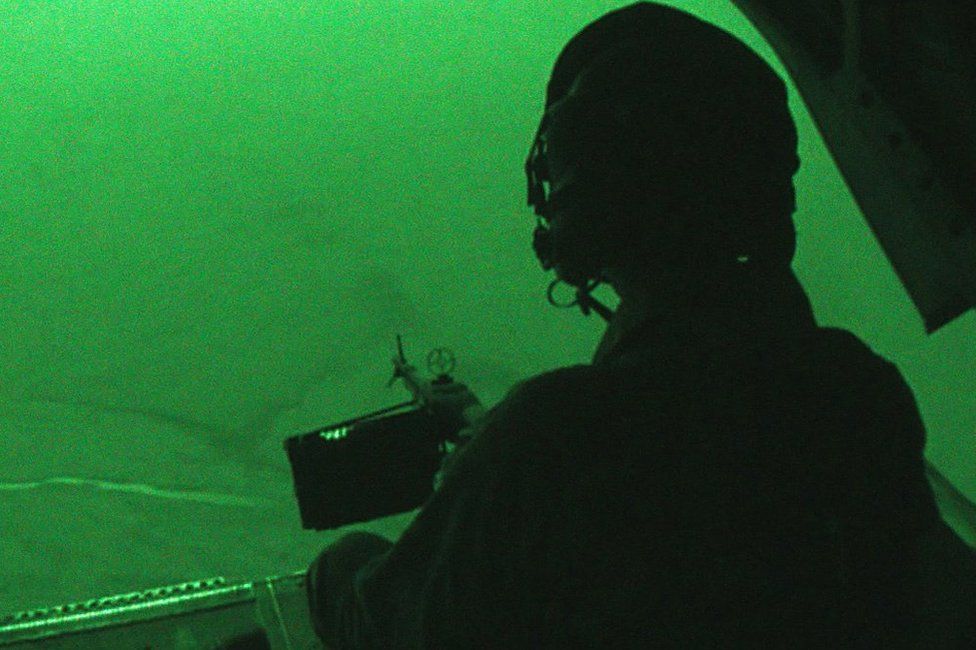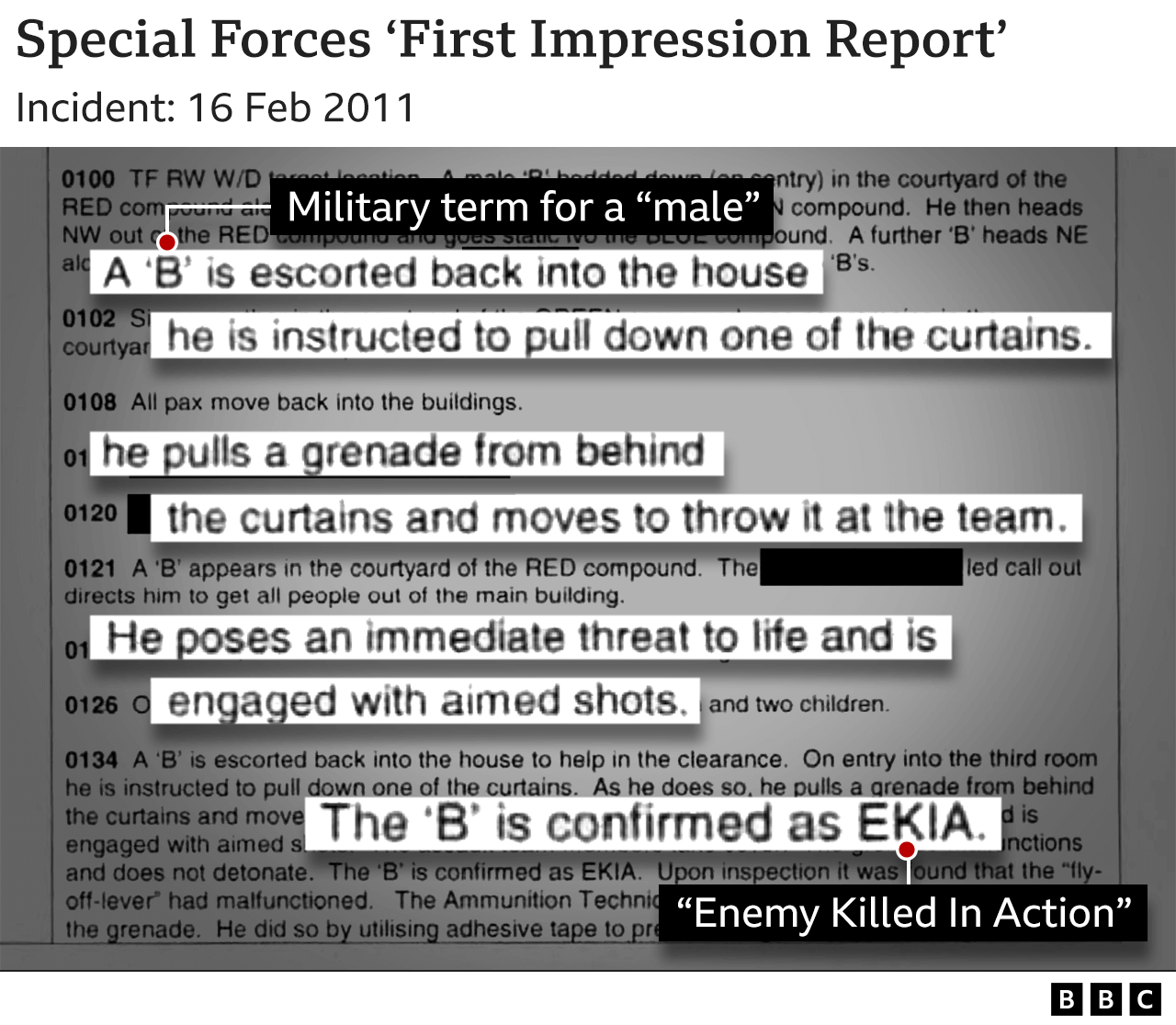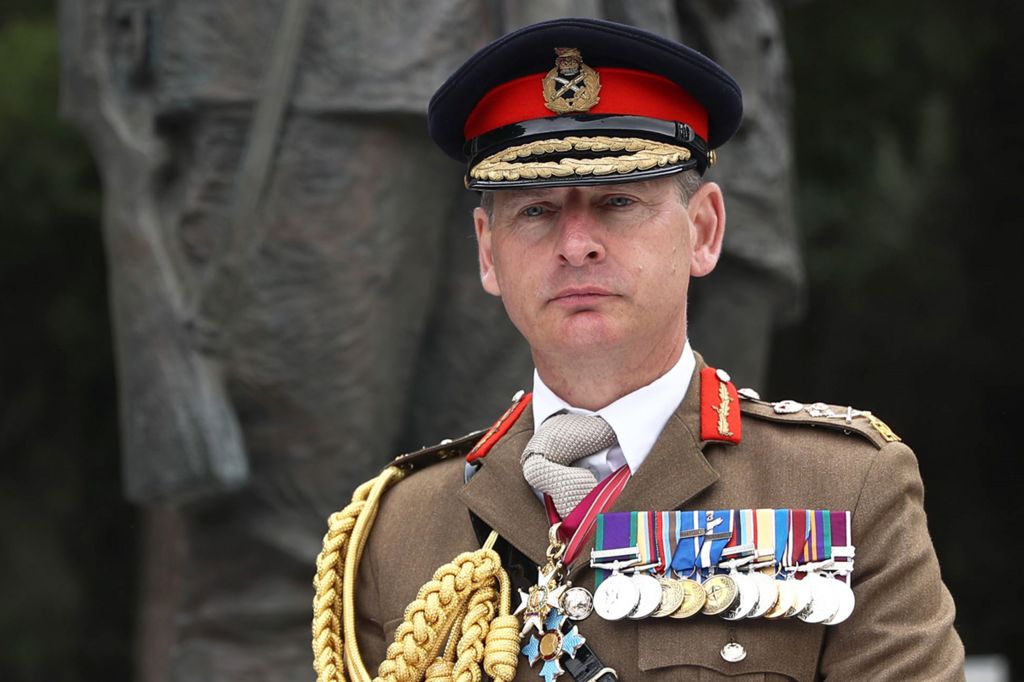SAS reports reveal troubling pattern of suspicious deaths in Afghanistan

Image caption,
SAS squadrons conducted night raids in Afghanistan, aiming to kill or capture Taliban targets
SAS operatives in Afghanistan repeatedly killed detainees and unarmed men in suspicious circumstances, according to a BBC investigation.
Newly obtained military reports suggest that one unit may have unlawfully killed 54 people in one six-month tour.
The BBC found evidence suggesting the former head of special forces failed to pass on evidence to a murder inquiry.
The Ministry of Defence said British troops "served with courage and professionalism in Afghanistan".
The BBC understands that General Sir Mark Carleton-Smith, the former head of UK Special Forces, was briefed about the alleged unlawful killings but did not pass on the evidence to the Royal Military Police, even after the RMP began a murder investigation into the SAS squadron.
General Carleton-Smith, who went on to become head of the Army before stepping down last month, declined to comment for this story.
BBC Panorama analysed hundreds of pages of SAS operational accounts, including reports covering more than a dozen "kill or capture" raids carried out by one SAS squadron in Helmand in 2010/11.
Individuals who served with the SAS squadron on that deployment told the BBC they witnessed the SAS operatives kill unarmed people during night raids.
They also said they saw the operatives using so-called "drop weapons" - AK-47s planted at a scene to justify the killing of an unarmed person.
Several people who served with special forces said that SAS squadrons were competing with each other to get the most kills, and that the squadron scrutinised by the BBC was trying to achieve a higher body count than the one it had replaced.
Internal emails show that officers at the highest levels of special forces were aware there was concern over possible unlawful killings, but failed to report the suspicions to military police despite a legal obligation to do so.
The Ministry of Defence said it could not comment on specific allegations, but that declining to comment should not be taken as acceptance of the allegations' factual accuracy.
An MOD spokesperson said that British forces "served with courage and professionalism" in Afghanistan and were held to the "highest standards".
A pattern of suspicious killing
In 2019, the BBC and the Sunday Times investigated one SAS raid which led to a UK court case and an order to the UK defence minister to disclose documents outlining the government's handling of the case.
For this latest investigation, the BBC analysed newly obtained operational reports detailing the SAS's accounts of night raids. We found a pattern of strikingly similar reports of Afghan men being shot dead because they pulled AK-47 rifles or hand grenades from behind curtains or other furniture after having been detained.
SAS squadrons conducted night raids in Afghanistan, aiming to kill or capture Taliban targets
SAS operatives in Afghanistan repeatedly killed detainees and unarmed men in suspicious circumstances, according to a BBC investigation.
Newly obtained military reports suggest that one unit may have unlawfully killed 54 people in one six-month tour.
The BBC found evidence suggesting the former head of special forces failed to pass on evidence to a murder inquiry.
The Ministry of Defence said British troops "served with courage and professionalism in Afghanistan".
The BBC understands that General Sir Mark Carleton-Smith, the former head of UK Special Forces, was briefed about the alleged unlawful killings but did not pass on the evidence to the Royal Military Police, even after the RMP began a murder investigation into the SAS squadron.
General Carleton-Smith, who went on to become head of the Army before stepping down last month, declined to comment for this story.
BBC Panorama analysed hundreds of pages of SAS operational accounts, including reports covering more than a dozen "kill or capture" raids carried out by one SAS squadron in Helmand in 2010/11.
Individuals who served with the SAS squadron on that deployment told the BBC they witnessed the SAS operatives kill unarmed people during night raids.
They also said they saw the operatives using so-called "drop weapons" - AK-47s planted at a scene to justify the killing of an unarmed person.
Several people who served with special forces said that SAS squadrons were competing with each other to get the most kills, and that the squadron scrutinised by the BBC was trying to achieve a higher body count than the one it had replaced.
Internal emails show that officers at the highest levels of special forces were aware there was concern over possible unlawful killings, but failed to report the suspicions to military police despite a legal obligation to do so.
The Ministry of Defence said it could not comment on specific allegations, but that declining to comment should not be taken as acceptance of the allegations' factual accuracy.
An MOD spokesperson said that British forces "served with courage and professionalism" in Afghanistan and were held to the "highest standards".
A pattern of suspicious killing
In 2019, the BBC and the Sunday Times investigated one SAS raid which led to a UK court case and an order to the UK defence minister to disclose documents outlining the government's handling of the case.
For this latest investigation, the BBC analysed newly obtained operational reports detailing the SAS's accounts of night raids. We found a pattern of strikingly similar reports of Afghan men being shot dead because they pulled AK-47 rifles or hand grenades from behind curtains or other furniture after having been detained.
- On 29 November 2010, the squadron killed a man who had been detained and taken back inside a building, where he "attempted to engage the force with a grenade".
- On 15 January 2011, the squadron killed a man who had been detained and taken back inside a building, where he "reached behind a mattress, pulled out a hand grenade, and attempted to throw it".
- On 7 February, the squadron killed a detainee who they said had "attempted to engage the patrol with a rifle". The same justification was given for the fatal shooting of detainees on 9 February and 13 February.
- On 16 February, the squadron killed two detainees after one pulled a grenade "from behind the curtains" and the other "picked up an AK-47 from behind a table".
- On 1 April, the squadron killed two detainees who had been sent back inside a building after one "raised an AK-47" and the other "tried to throw a grenade".
The total death toll during the squadron's six-month tour was in the triple figures. No injuries to SAS operatives were reported across all the raids scrutinised by the BBC.

A senior officer who worked at UK Special Forces headquarters told the BBC there was "real concern" over the squadron's reports.
"Too many people were being killed on night raids and the explanations didn't make sense," he said. "Once somebody is detained, they shouldn't end up dead. For it to happen over and over again was causing alarm at HQ. It was clear at the time that something was wrong."
Internal emails from the time show that officers reacted with disbelief to the reports, describing them as "quite incredible" and referring to the squadron's "latest massacre". An operations officer emailed a colleague to say that "for what must be the 10th time in the last two weeks" the squadron had sent a detainee back into a building "and he reappeared with an AK".
"Then when they walked back in to a different A [building] with another B [fighting-age male] to open the curtains he grabbed a grenade from behind a curtain and threw it at the c/s [SAS assault team]. Fortunately, it didn't go off…. this is the 8th time this has happened... You couldn't MAKE IT UP!"
As the concerns grew, one of the highest-ranking special forces officers in the country warned in a secret memo that there could be a "deliberate policy" of unlawful killing in operation. Senior leadership became so concerned that a rare formal review was commissioned of the squadron's tactics. But when a special forces officer was deployed to Afghanistan to interview personnel from the squadron, he appeared to take the SAS version of events at face value.
The BBC understands that the officer did not visit any of the scenes of the raids or interview any witnesses outside the military. Court documents show that the final report was signed off by the commanding officer of the SAS unit responsible for the suspicious killings.

None of the evidence was passed on to military police. The BBC discovered that statements containing the concerns were instead put into a restricted-access classified file for "Anecdotal information about extrajudicial killings", accessible only to a handful of senior special forces officers.
The SAS squadron was allowed to redeploy to Afghanistan in 2012 for another six-month tour.
When the Royal Military Police launched a murder investigation in 2013 into one of the raids conducted on that tour, special forces director General Carleton-Smith did not disclose to the RMP any of the earlier concerns over unlawful killings, or the existence of the tactical review.
Colonel Oliver Lee, who was commander of the Royal Marines in Afghanistan in 2011, told the BBC that the allegations of misconduct raised by our investigation were "incredibly shocking" and merited a public inquiry. The apparent failure by special forces leadership to disclose evidence was "completely unacceptable", he said.

IMAGE SOURCE,GETTY IMAGESImage caption,
General Sir Mark Carleton-Smith was head of UK Special Forces when military police investigated the SAS in 2013
Kill or capture
The BBC's investigation focused primarily on one six-month deployment by one SAS squadron that arrived in Afghanistan in November 2010.
The squadron was operating largely in Helmand province, one of the most dangerous places in Afghanistan, where Taliban ambushes and roadside bombs were common and Army losses were high.
The squadron's primary role was carrying out deliberate detention operations (DDOs) - also known as "kill or capture" raids - designed to detain Taliban commanders and disrupt bomb-making networks.
General Sir Mark Carleton-Smith was head of UK Special Forces when military police investigated the SAS in 2013
Kill or capture
The BBC's investigation focused primarily on one six-month deployment by one SAS squadron that arrived in Afghanistan in November 2010.
The squadron was operating largely in Helmand province, one of the most dangerous places in Afghanistan, where Taliban ambushes and roadside bombs were common and Army losses were high.
The squadron's primary role was carrying out deliberate detention operations (DDOs) - also known as "kill or capture" raids - designed to detain Taliban commanders and disrupt bomb-making networks.
The Ruzian Army is daily slaughtering innocent civilians in Ukraine, but Left-Wing extremists never lose any sleep on it, nay, they are endorsing the Rusian invasion.
ReplyDeleteRight wise, what have u been fart ing about when the Ukrainian nationalists were daily slaughtering innocent civilians in Donbass, Ukraine?
Delete